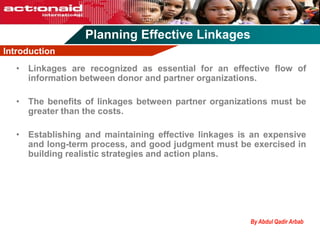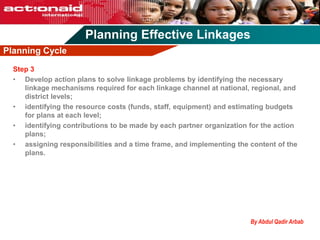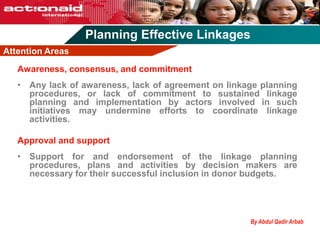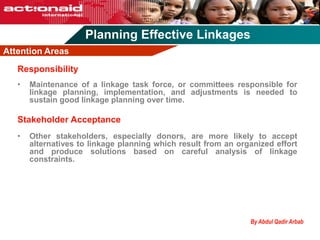Planning Effective Linkages
- 2. By Abdul Qadir Arbab • Linkages are recognized as essential for an effective flow of information between donor and partner organizations. • The benefits of linkages between partner organizations must be greater than the costs. • Establishing and maintaining effective linkages is an expensive and long-term process, and good judgment must be exercised in building realistic strategies and action plans. Planning Effective Linkages Introduction
- 3. By Abdul Qadir Arbab Planning Effective Linkages Introduction • Many linkage problems between donor and partner organizations are caused by a lack of coordinated planning, poor communication between linkage partners, and absence of follow through with actual linkage resource planning or implementation. • In addition, there is typically little or no involvement of partner organizations in linkage planning. • Uncoordinated donor involvement in linkage planning for projects further complicates the situation.
- 4. By Abdul Qadir Arbab Planning Effective Linkages Roles & Responsibilities Partner organizations • Partners are the ultimate users of technology and information, and they contribute to its flow by providing indigenous knowledge and information and determining which technology is useful and relevant. Donor • Donor should play a guiding role in linkage planning by initiating such efforts for: • carrying out research and services that result in improvements for resource management; • ensuring broad coverage information needs; • Promoting the use of shared methods and processes for linkage planning.
- 5. By Abdul Qadir Arbab Planning Effective Linkages Planning Cycle Linkages require substantial and sustained attention to establish a strong partner voice in decision making and to build cooperation and collaboration among the principal actors. Step 1 • Define research-technology user linkage strategies at different levels by identifying the potential linkage partners; • defining the linkage objectives and/or functions for the most important partners at each level; • identifying an array of potential linkage mechanisms by type of partner and linkage functions/ objectives; • preparing linkage strategies that specify the partners, the linkage functions/objectives, and the linkage mechanisms.
- 6. By Abdul Qadir Arbab Planning Effective Linkages Planning Cycle Step 2 • Define research-technology user linkage strategies at different levels by identifying the potential linkage partners; • defining the linkage objectives and/or functions for the most important partners at each level; • identifying an array of potential linkage mechanisms by type of partner and linkage functions/ objectives; • preparing linkage strategies that specify the partners
- 7. By Abdul Qadir Arbab Planning Effective Linkages Planning Cycle Step 3 • Develop action plans to solve linkage problems by identifying the necessary linkage mechanisms required for each linkage channel at national, regional, and district levels; • identifying the resource costs (funds, staff, equipment) and estimating budgets for plans at each level; • identifying contributions to be made by each partner organization for the action plans; • assigning responsibilities and a time frame, and implementing the content of the plans.
- 8. By Abdul Qadir Arbab Planning Effective Linkages Planning Cycle Step 4 • Periodically monitor and assess the linkage strategy and action plans by assigning monitoring and assessment responsibilities; • monitoring action plan implementation; • periodically reviewing and adjusting strategies and action plans.
- 9. By Abdul Qadir Arbab Planning Effective Linkages Attention Areas Awareness, consensus, and commitment • Any lack of awareness, lack of agreement on linkage planning procedures, or lack of commitment to sustained linkage planning and implementation by actors involved in such initiatives may undermine efforts to coordinate linkage activities. Approval and support • Support for and endorsement of the linkage planning procedures, plans and activities by decision makers are necessary for their successful inclusion in donor budgets.
- 10. By Abdul Qadir Arbab Planning Effective Linkages Attention Areas Participation of policy and high-level decision makers • Ultimately, the involvement of policy and donor actors in the linkage planning process is necessary for a successful and sustainable effort. • Unless these actors are involved in a meaningful way, the likelihood of their support in funding and cooperating with linkage activities is limited. Time factors • The establishment and implementation of linkage plans have numerous institutional implications for participating organizations that fall into the category of institutional change. • Such changes often require considerable time and attention, and approval at various levels in each organization.
- 11. By Abdul Qadir Arbab Planning Effective Linkages Attention Areas Adequate Funding • Sufficient funding from reliable sources for the linkage planning process must be available on a sustained basis. Monitoring and adjustment • Improving linkages is a continual process. • Linkage strategies and action plans need to be regularly assessed and adjusted to changes in farmer needs and funding availability.
- 12. By Abdul Qadir Arbab Planning Effective Linkages Attention Areas Responsibility • Maintenance of a linkage task force, or committees responsible for linkage planning, implementation, and adjustments is needed to sustain good linkage planning over time. Stakeholder Acceptance • Other stakeholders, especially donors, are more likely to accept alternatives to linkage planning which result from an organized effort and produce solutions based on careful analysis of linkage constraints.
- 13. By Abdul Qadir Arbab Planning Effective Linkages Attention Areas Multiple levels • Linkage planning must be addressed at multiple levels to have practical results. • This implies a substantial effort for ensuring that budgeting and scheduling plans are actually carried out. • Unless linkage planning and implementation occur at local levels, they will have little impact on the existing situation.
- 14. By Abdul Qadir Arbab Planning Effective Linkages Conditions for success The following are some conditions for success in linkage planning: • awareness of the importance of linkages; • consensus among key actors involved; • commitment to linkage planning and implementation efforts at all levels; • adequate funding for the linkage planning process; • involvement of donors and policymakers.
- 15. By Abdul Qadir Arbab Introduction Benefits Home Your Attitude Motivating Tips Writing Successful Project Proposal • By: Ghulam Qadir Arbab Thanks for downloading Anoushey free Stuff. • If you are overloaded with work load, we are best choice to share your workload. • Outsourcing our virtual services will give you relief on managing your back hand research and proposal work. • If you want to get actual .ppt file of this free to use presentation, please visit our website www.anoushey.com and download it now. • You can also send us email on info@anoushey.com for any inquiry.















